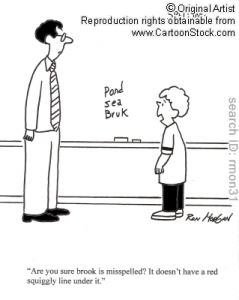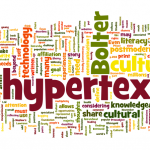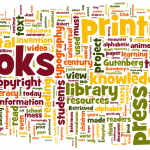Add me to the Weblog!
If you want to add yourself to this blog, please log in.
Categories
Authors
Recent Comments
- coffeys on Digital Literacy and Law Enforcement
- Annette Smith on Gord Higginson’s ETEC 540 Rip.Mix.Feed
- Annette Smith on Making Connections
- Annette Smith on Making Connections: Opening Doors (cautiously?)
- coffeys on Gord Higginson’s ETEC 540 Rip.Mix.Feed
Archives
Tags
- adora
- Assignment 3
- Bolter
- Chandler
- commentary 1
- commentary 2
- communication
- connections
- education
- ETEC540
- Feed
- Final thoughts
- history
- hypertext
- Ifeoma
- images
- information
- introduction
- Invention
- Iris
- Jung
- language
- learning
- literacy
- media
- memory
- Mix
- multiliteracies
- Ong
- orality
- Postman
- Power
- reading
- remediation
- research paper
- Rip
- rip.mix.feed
- technology
- text
- vicki
- video
- visual
- words
- writing
RIP.MIX.FEED
Posted in Discussion, Making Connections
1 Comment
Major Project – Text spaces in Augmented Reality (AR)
Hi Everyone. I’ve put together a Major Project as my course assignment and made a page for it on a separate personal blog to save space here at Text Technologies.
The link for my Major Project is here
My project looks at the background of Augmented Reality and its applications in making new kinds of books happen. AR uses a webcam, video monitor and computer to overlay texts, graphics, animations and 3D models onto flat surfaces like the pages of a book or magazine. It can also superimpose texts and graphics onto displays of hand-held devices like mobile phones, so that the virtual elements look like they are out there in the real world.
There is one really great video example of the AR book technology that prompted me to research it in greater depth. It is the thesis project “Jekyll and Hyde Augmented Reality Book” created by students Marius Hügli and Martin Kovacovsky at HGK Basel. I’ve pasted the video:

If this sparks your interest in AR and AR books, you’re invited to have a look at my Major Project, and my related Rip.Mix.Feed video and Youtube Channel, on the personal blog. Cheers.
Rip.Mix.Feed
My Rip.Mix.Feed video is a kind of sidebar to my Major Project, which is about the use of Augmented Reality in creating new types of interactive books and other media.
One of the challenges that I encountered in researching Augmented Reality was in understanding what is known as the “immersive” effect that the technology creates. The idea of an immersive experience that goes beyond the limited example of a digital pop-up illustration is hard to evoke when describing pages in a book.
For reasons that are explored in my Major Project, it is actually easier to imagine of AR virtual elements floating in a three-dimensional space than on the printed page of a book.
In order to satisfy my own curiosity about the latest in augmented reality book publishing, I ordered author Robert Mash’s and illustrator Stuart Martin’s book Dinosaurs Alive!, which is published in the UK by Carlton books. It is the most advanced example of an AR book that I could find.
This video I made is basically a walk-through of the book that tries to highlight its educational potential along with its great visual effects. I tried to show how the book’s editorial, artwork and layout features are designed to respond to the inclusion of AR in the content. This helps to give a visual example of some of the ideas I discuss in the Major Project.
A Short Video Tour of a Published Augmented Reality (AR) Book
[For a better view of the text’s details, view in Youtube at 480p resolution, or in full screen mode]
The reason that I chose this book was that it is clearly intended for older children, at least over 10 years old. It is very dense with information about its subject matter–a survey of dinosaurs and their rise from the earliest species to extinction. Dinosaurs Alive! is definitely an educational book, but the main appeal that sets it apart from other books is the built-in thrill factor of seeing the enhanced dinosaurs do their thing. My Major Project attempts to define some ways in which AR books might offer more than this type of appeal in the future.
A few notes about the book and video:
- The black-and-white dinosaur eye design that you see is the marker that triggers and orients the 3D effects. These have been worked into the graphic design of the book using a few repeating visual metaphors, such as the crates that hold the dinosaurs.
- When you see the dinosaurs walk, turn, or fight each other, I am clicking the arrow keys and space bar to make these actions happen from outside the frame.
I have also created a Youtube Channel that compiles many of the videos that I used as research and information in writing my Course Assignment. It links the best examples I could find of AR technology that is used in table-top situations. I hope you enjoy the video; please visit the Major Project page if you are interested in finding out more about this topic.
Posted in Rip.Mix.Feed
Leave a comment
connections and directions
This course opened my eyes to the history of text and the emergence of multiliteracies. I watched the latest Robin Hood (with Russell Crow) a week or so ago. Set around 1200, I couldn’t help but notice how the written work incorporated in it (edicts, etc.) had those handy spaces between words, and weren’t very historically accurate. Aside from movie critiques (which will now probably continue), I’ve found myself looking at literacy and the evolution of how we communicate from a very new perspective. I feel that in this new digital age, we’re probably going to begin to see more remarkable changes in how text is used (or not) in future communication. It reminds me that we’re at a very interesting crossroads in how communication takes place.
Some of the conversations on new forms of colonial-like outcomes vis-a-vis corporate (and open-source) programs has also given me pause. The default language settings in word processors and even in applications like email now cause me to question the negative outcomes in terms of conformity in this regard. Perhaps it is the integration of text in novel ways through new multimodal communication that this will be tempered. I’ve also been forced to think about my own choices in terms of disseminating ideas, and come to the conclusion that for better or worse, I’m more or less a luddite. Even with the choice to do some assignments using new media, I tend to stick with the paradigm I’ve been in – essays/text-dominated writing – for the most part. So while I embrace the idea of new forms of expression and find them invigorating, my personal change will probably follow a slow path. I think part of this is context. In non-academic settings, I think I’m more likely (and have been) to integrate multimedia and non-text elements, but I’m reminded that the indoctrination I’ve been subject to over many years that places writing, particularly traditional essay writing, will take effort and persistence to change. Part of the draw to Web 2.0 for student assignments and activities that appeals to me is that through more collaboration and interaction, I can see how students can engage and develop/share ideas in ways that are meaningful.
Another aspect that is very intriguing, from my place as a language instructor, is what this means in terms of how language might be best taught. I now wonder if in the future the focus on language instruction will change. There has been an ongoing swing in emphasis between form (accuracy) and function (communication), and it seems to me that language instruction is going to head to a new place where multimodal communication will need to be incorporated in teaching languages. I’m sure that this will cause tension, but will also offer novel ways that we can engage students in meaningful learning, particularly in academic preparation programs.
Posted in Making Connections, Reflections
Tagged connections, language education, multiliteracy
1 Comment
Finally Making those Connections
For this final task I decided to try another activity – Wordle. I thought this might be a good exercise because in a way in links those words and phrases that have been integral to the journey.
This journey has been interesting to say the least. I thought I had signed up for one thing… got something completely different… but in the end we ended up where I thought we would. To be honest I wasn’t thrilled about the origins of the course and if wasn’t for the fact that I needed this course for my PB+15 I would have dropped it. I have courses about to expire and I needed this course to “keep them” (long and complicated story). I guess what I am getting at is I am glad I stayed the course – I really enjoyed it (honestly)!! Like I said if I didn’t have to I would have dropped it and I would have missed out on so much.
I would like to thank Jeff Miller, my classmates and the designers of this course. So much of this MET program does not include practical examples and practices of technology, web 2.0, social media, etc. It is my opinion that is courses like these that are most meaningful to me and my career. I take examples and practices from this course and immediately implement them into my teachings.
I want to wish you all luck, say “thanks” (again) and wish you a happy and restful holidays!
Ryan
Here is my Wordle (I entered terms that were meaningful to me as well as the link to our class blog). This is what was generated – if you click on the thumbnail you will get an enlarged version:
Posted in Making Connections, Reflections
3 Comments
Making Connections – Know Students Left Behind
Upon reflection, my journey through ETEC 540 placed me in a position of having to think about how Web 2.0 technologies and Web 2.0 spaces can work to support students with severe special needs (hereafter ‘students’). Too often, the public education system, for example, relies on assistive technologies that are static, rigid, and user-centric (no social networking or social collaboration features), rather than fluid, flexible, and dynamic.
Indeed, ETEC 540 is a platform that invites us to explore and to investigate various spaces of reading and writing, from hypertexts to social media (e.g. blogs, wikis, tagging) and multimedia (e.g. YouTube). Although ETEC 540 is not defined as a community of practice (CoP), we did share and exchange content, information, opinions, ideas, and thoughts about, at least, education, politics, and learning theories in spaces like discussion forums and wiki postings. Here, a tremendous amount of knowledge was brought into two main social-communicative platforms that are much greater than any classroom with four walls.
In turn, this leads me back to how Web 2.0 technologies and Web 2.0 spaces can work to support the said students. The world of text technologies is one way, as evidenced by this course. Indeed, these students can participate and engage in reading and writing spaces that take place on the Web. Just as we have done, these students can do the same at an appropriate and suitable level. Here, I am very excited to know that there are opportunities for great learning, for collective knowledge is readily available.
Indeed, understanding technology is not so much about knowing how to use the hardware and the software as it is about knowing the purpose and the meaning behind the technology. Here, it is about expanding social networks, building social communities, and building knowledge. In this regard, the said students should be apart of this experience as well. Indeed, reading the various posts in the discussion forums and in the Weblog has led me to believe that there is room for such changes in thinking and in understanding how everyone can participate on and contribute to the Web… and have a positive presence.
I share the belief that text and social technologies are evolving in that they are becoming more pervasive, interactive, and accessible. After all, for this course, I have used Web spaces and Web tools that have connected me to my course mates, which, only a few years ago, did not exist in this particular fashion. How beneficial this would be for students who would otherwise not have an opportunity to experience this type of social interaction, positive engagement, and shared communication. Indeed, what resonates with me is that this course has taught me that this journey is only the beginning. That is, I would like to continue to bring what I have learned here into my classroom, into my school, and even into my district, for I believe that both text and social technologies complement and support differentiated instruction and Universal Design for Learning (UDL). After all, these technologies allow for interaction, communication, and collaboration as well as knowledge building and sharing in a way that no student needs to be left behind.
Google Image:
http://drpfconsults.com/the-real-truth-about-no-child-left-behind/
Posted in Reflections
6 Comments
Making Connections: Change
 My reflection on the last three months is similar to the conclusion that Melanie Wong reached in her “Making Connections: Final thoughts” post, specifically the theme of change. I am reminded of my initial post in this course and the quote I used from Postman (1992) “new technologies alter the structure of our interests; the things we think about” (p.20). As the course progressed I realized how accurate the quote had become as we explored and discovered how technology has changed over the years. Changes in what we view as technology; changes in how technology develops; and change in the opportunities people have in education because of the development of technology.
My reflection on the last three months is similar to the conclusion that Melanie Wong reached in her “Making Connections: Final thoughts” post, specifically the theme of change. I am reminded of my initial post in this course and the quote I used from Postman (1992) “new technologies alter the structure of our interests; the things we think about” (p.20). As the course progressed I realized how accurate the quote had become as we explored and discovered how technology has changed over the years. Changes in what we view as technology; changes in how technology develops; and change in the opportunities people have in education because of the development of technology.
In “E-Readers: Supporting Students with Reading Difficulties“, Barrie Carter explores an innovative development in assistive technologies and how e-readers have the potential to assist students with reading difficulties that would allow them to reach a similar reading ability as their peers. I was very excited by this because I tutored university students with learning and reading disabilities while I was doing my undergraduate degree and this technology will certainly be an excellent addition to the limited number of tools that are currently available for students. This will certainly change the way they learn and hopefully improve their ability to follow a standard educational path. Regrettably, change is not always for the positive. The week we looked at the Calculator of the Humanist. Ryosuke Suzuki, in addition to other students, discussed the positive and negative effects in using an automatic spelling and grammar checker, in the thread “Word Processing – Spelling”. While I wouldn’t say that these checkers have had a negative impact, it is difficult to argue with the fact that many people have become dependant on the technology to the point that they are incapable of writing correctly without it. This is a great example of how the impact of technology can completely different depending on the individual.
I am taking three courses this semester (and it is my first) and I can admit that the experience has been enjoyable, educational and overwhelming at the same time. It is interesting to see how much I have already learned and I can’t wait to see how my personal beliefs continue to develop in regards to educational technology.
Resources
Carter, B. (2010). E-readers: supporting students with reading difficulties. Retrieved from https://blogs.ubc.ca/etec540sept10/2010/11/29/e-readers-supporting-students-with-reading-difficulties/.
Postman, N. (1992). Technopoly: the surrender of culture to technology. New York, NY: New York.
Suzuki, R. Calculator of the humanist: word processing – spelling. (ETEC 540 Vista Thread, October 25, 2010).
Wong, M. (2010). Making connections: final thoughts. Retrieved Dec 2010 from https://blogs.ubc.ca/etec540sept10/2010/11/28/making-connections-final-thoughts/.
Final Thoughts
Hello ETEC 540 Community,
Thank you all for a wonderful 13 weeks of learning together. The MET program is so rich in terms of not only the caliber of the courses, but the collective knowledge of the participants. It is a privilege to learn along side all of you!
For my final thoughts, I decided to do an informal experiment with Wordle. Wordle is a toy for generating “word clouds” from text that you provide. The clouds give greater prominence to words that appear more frequently in the source text. You can tweak your clouds with different fonts, layouts, and color schemes. I created one Wordle with the RSS feed from the Community Weblog, and another Wordle with the RSS feed from my entries on the Community Weblog alone. Here are the results:
- Community Weblog Contributions
- Personal Weblog Contributions
The results were very interesting! The top word for the Weblog overall was hypertext and the top word from my entries was books. How appropriate as we really have moved from studying different forms of print right through to digital forms of text as Ashley Ross demonstrates in her Major Project “The Evolution of Advertising: From Papyrus to YouTube“. When I look back on the progression of my entries, I see that right from my first entry about a child’s alphabet through to my Major Project on Typography that my progression in this course was fuelled by an interest in print.
This journey has been fascinating and at times, it pushed me out of my comfort zone. I’m not much of a history buff, so I really appreciated Laura Bonnor’s thorough research project, “How the Fall of Rome Leads to the Development of the Gutenberg Press“. Laura’s detailed account helped me to make connections to other research projects, including my own, and to the readings.
ETEC 540 kept us all on our toes with the different platforms we used; Vista, the Community Weblog and the Wiki. Using the three different areas to showcase our knowledge was a valuable experience. As we develop our skills in educational technology, we learn to do the work by doing the work. As graduates of the MET program, we must be well versed in the tools available to us and one could argue that we only used one platform, a browser.
Thank you all again for your knowledge, skills and participation. Good luck in the New Year and Happy Holidays!
Camille
Posted in Making Connections
Leave a comment
Some thoughts
 The journey is getting to its end!
The journey is getting to its end!
It was an amazing exploration from Orality culture to digital Literacy!
I enjoyed most of the readings. We covered a lot in the course. There were so many interesting posts, but “The Natives are Restless” by Laura Bonnor and Soraja Rajan indeed engaged me because of their critics to the over enthusiasm to new technologies in education. It also call my attention how well they articulated two articles.
I am visual learner, too and enjoy visual used by the participants. I didn’t do as much I would like to because of time.
Rita
Posted in Making Connections
Leave a comment
The Life of Salmon
Hello Everyone:
Please view my short slideshow on ‘The Life of Salmon’ at http://gallery.me.com/mycourses. I used Camtasia for the slideshow.
I decided to do a slideshow on the life of salmon because I witnessed the famous salmon run at Adams River in Chase, B.C.
Lastly, I submitted my work in the discussion forum yesterday, but I wanted to include it here as well. Enjoy! 🙂
Cheers,
Barrie
Posted in Rip.Mix.Feed
Leave a comment







